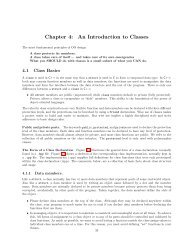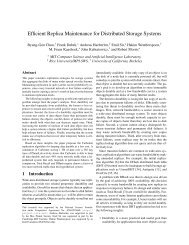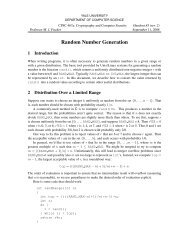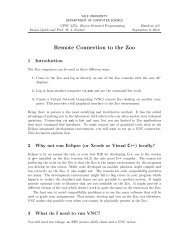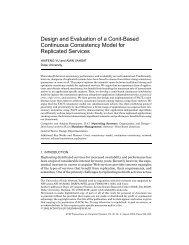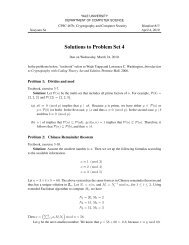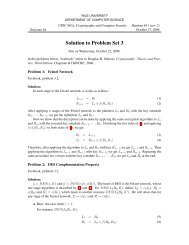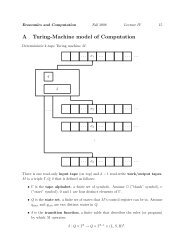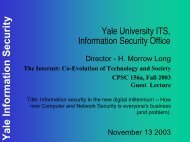Unreliable Failure Detectors for Reliable Distributed Systems
Unreliable Failure Detectors for Reliable Distributed Systems
Unreliable Failure Detectors for Reliable Distributed Systems
You also want an ePaper? Increase the reach of your titles
YUMPU automatically turns print PDFs into web optimized ePapers that Google loves.
<strong>Unreliable</strong> <strong>Failure</strong> <strong>Detectors</strong> <strong>for</strong> <strong>Reliable</strong> <strong>Distributed</strong> <strong>Systems</strong> 265We now show that the above lower boundis tight:THEOREM A3.3. In asynchronous systems with m 5 n – f, Consensus can besolved using Y@(m).PROOF. Suppose m < n - f, and consider any failure detector QilE SPW(m).Since m, the number of mistakes made by ‘3, is less than the number of correctprocesses, there is at least one correct process that ~ never suspects. Thus, ~satisfies weak accuracy. By the definition of Y9(m ), Q also satisfies weakcompleteness. So ‘2 E W, and it can be used to solve Consensus (Corollary6.1.9).Suppose m = n - f. Even though $3 can now make a mistake about everycorrect process, it can still be used to solve Consensus (even if a majority of theprocesses are faulty). The corresponding algorithm uses rotating coordinators,and is similar to the one <strong>for</strong> OW given in Figure 6. Because of this similarity, weomit the details, ❑From the above two theorems:COROLLARY A3.4. in asynchronous systems with f z [n/21, Consensus can besolved using X%(m) if and only if m s n – f.We now turn our attention to solving Consensus using W ~(m ).THEOREM A3.5. In asynchronous ~stems with f ? rn/21, Consensus cannot besolved using W%(m) with m > 0.PROOF. In Theorem A3,2, we described a failure detector ~ that cannotbe used to solve Consensus in asynchronous systems with f = rn / 21. It is easyto verify that ~ makes at most one mistake about each correct process, and thus!2 E w%(l). ❑From Corollary A2.2, and the above theorem, we have:COROLLARY A3.6. In asynchronous systems with f ? [n/21, Consensus can besolved using W%(m) if and only if m = O.ACKNOWLEDGMENTS. We are deeply grateful to Vassos Hadzilacos <strong>for</strong> hiscrucial help in revising this paper. The comments and suggestions of theanonymous referees, Navin Budhiraja, and Bernadette Charron-Best, were alsoinstrumental in improving the paper. Finally, we would like to thank PrasadJayanti <strong>for</strong> greatly simplifying the algorithm in Figure 3.REFERENCESAMIR, Y., DOLEV, D,, KRAMER, S., ANDMALKI,D. 1991. Transis: A communication sub-system <strong>for</strong>high availability. Tech. Rep. CS91-13 (Nov.), Computer Science Department, The HebrewUniversity of .Ierusalem, Jerusalem, Israel.ATrIYA, H., BAR-N• Y, A., DOLEV, D., KOLLER, D., PELEG, D., AND REISCHUK, R. 1987. Achievablecases in an asynchronous environment. In Proceedings of the 28rh Symposium on Foundationsof Compufer Science (Oct.), IEEE Computer Society Press, Washington, D.C., pp. 337-346.ATTIYA, H,, DWORK, C., LYNCH, N., AND STOCKMEYER,L. 1991. Bounds on the time to reachagreement in the presence of timing uncertainty. Irr Proceedings of rhe 23rd ACM Symposium CMTheory of Computing (New Orleans, La,, May 6-8). ACM, New York, pp. 359-369.BEN-OR, M, 1983. Another advantage of free choice: Completely asynchronous agreement protocols.1n Proceedings of the 2nd ACM Symposium on Principles of <strong>Distributed</strong> Compuring (Montreal,Que.. Canada, Aug. 17-19). ACM, New York, pp. 27-30.



